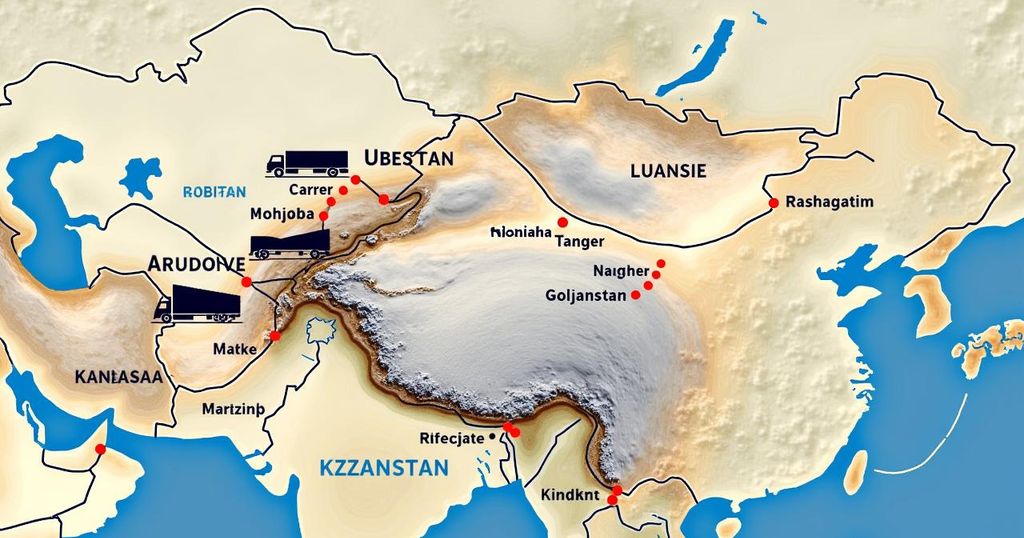The Complex Transport Dynamics Between Uzbekistan and Kazakhstan in Central Asia
The article examines the transport dynamics between Uzbekistan and Kazakhstan amid increasing transit demands in Central Asia. It highlights both cooperation efforts in developing transport infrastructure and the competitive tensions regarding access to markets via international transit routes. The Trans-Caspian International Transport Route (TITR) plays a pivotal role in this context, as both nations navigate their ambitions to enhance trade connectivity.
Recent geopolitical shifts have underscored Central Asia’s emerging role as a critical transit corridor connecting major global markets. This strategic positioning is aimed at enhancing transport connectivity and facilitating the integration of Central Asian republics into worldwide supply chains. However, cooperation among the five Central Asian nations remains limited, with a greater emphasis placed on international transit corridors than on local connectivity. This has led to insufficient coordination, duplicated efforts, and competition, particularly between Kazakhstan and Uzbekistan as both nations strive for access to the European and Turkish markets via the Caspian Sea. In an initiative to strengthen multilateral cooperation in transport communication, the Central Asian states convened Consultative Meetings starting in 2018. Among the key priorities identified was the alignment of national transport systems to boost trade and expand regional transit capabilities. Proposed strategies included the establishment of a Regional Center for Transport and Communications Interconnectivity under the United Nations, the development of a Regional Transport Corridor Development Strategy, and the implementation of a Regional Program for Transport Communication Development. Although progress remains languid after several years, some advancements have been made, such as the resumption of railway services between Uzbekistan and Tajikistan, leading to a significant increase in bilateral trade. This trend continues with the launch of the Tashkent-Andijan-Osh-Irkeshtam-Kashgar multimodal corridor, further enhancing mutual trade between Uzbekistan and Kyrgyzstan. Uzbekistan and Kazakhstan are actively pursuing local transport initiatives as the largest economies in Central Asia, which account for the majority of intra-regional trade. A notable project includes the construction of the Uchkuduk-Kyzylorda road and railway, designed to connect Kazakhstan’s Kyzylorda region with Uzbekistan’s Navoi region, effectively tripling the distance reduction for transit. Additional railway and road projects, such as the Darbaza-Maktaaral railway line and the Beineu-Shalkar road, are also in the pipeline. Despite these cooperative ventures, competition persists, particularly concerning the Trans-Caspian International Transport Route (TITR), also referred to as the Middle Corridor. The route, which connects China to Europe via Central Asia, has seen increased demand following the geopolitical turmoil in Ukraine that has subsequently surged volumes transiting through this corridor. In 2023, cargo volumes via this route reached 2.7 million tons, with projections suggesting an increase to 4.2 million tons in 2024. As container transit from China through this corridor has seen a 14-fold increase since the beginning of the year, there is significant potential for capacity expansion to accommodate up to 10 million tons of cargo annually. Experts from the European Bank for Reconstruction and Development (EBRD) highlight the presence of three main transit routes within the Middle Corridor, including routes through Kazakhstan and direct paths involving Kyrgyzstan, Uzbekistan, and Turkmenistan. Kazakhstan’s geostrategic positioning enhances its importance within the China–European Union supply chain due to its proximity to both China and Russia. Uzbekistan is similarly working to establish itself as a critical transit hub along transportation routes between China and Europe. The country’s involvement in multimodal transport development supports its regional ambitions, particularly projects connecting Kyrgyzstan, Uzbekistan, Turkmenistan, the Caspian Sea, and wider Europe. The construction of a railway along the Kyrgyzstan–Uzbekistan route is anticipated to significantly reduce transit times for cargo from two days to ten days compared to the longer route through Kazakhstan. The dynamics within trans-Caspian transport development showcase a duality of partnerships and competition among Central Asian states. For instance, Uzbekistan and Kazakhstan’s agreement on the Uchkuduk-Kyzylorda railway exemplifies cooperative efforts to interlink the Kazakh section of the TITR. Additionally, a consortium was formed in 2019 by Uzbekistan, Kyrgyzstan, Turkmenistan, Azerbaijan, Georgia, and Turkey to promote an alternative trade route to Europe through the Caspian Sea, known as the CASCA+ corridor. The institutionalization of the Middle Corridor through the establishment of the International Association “Trans-Caspian International Transport Route” by Kazakhstan, Azerbaijan, and Georgia highlights the complexities and fragmentation inherent within Central Asian transport development efforts. To foster regional cohesion, it is essential for Uzbekistan and Kazakhstan to harmonize their transport projects and develop joint coordination mechanisms that ensure equality and mutual benefits in transit transportation along the strategically vital China-Europe axis.
The article discusses the evolving transport dynamics in Central Asia amidst changing geopolitical landscapes, particularly in relation to the increasing significance of transit routes linking Asia and Europe. It highlights efforts by Central Asian states to enhance connectivity, trade potential, and transit capabilities, while also examining the challenges of competition and insufficient cooperation among these countries. The evolving transport corridors, particularly the Trans-Caspian International Transport Route (TITR), are central to the discussion, along with specific projects undertaken by Uzbekistan and Kazakhstan.
In conclusion, while Uzbekistan and Kazakhstan are making strides in advancing their transport networks and enhancing regional trade, the competition and lack of cohesive strategies among the Central Asian republics pose significant hurdles. Given the strategic importance of Central Asia in facilitating east-west trade, it is critical that these nations work collaboratively to align their transport initiatives, optimize resource utilization, and establish joint management frameworks to capitalize on their geographical advantages. Such efforts can potentially yield mutual economic benefits and bolster their roles in the global supply chain.
Original Source: daryo.uz








Post Comment